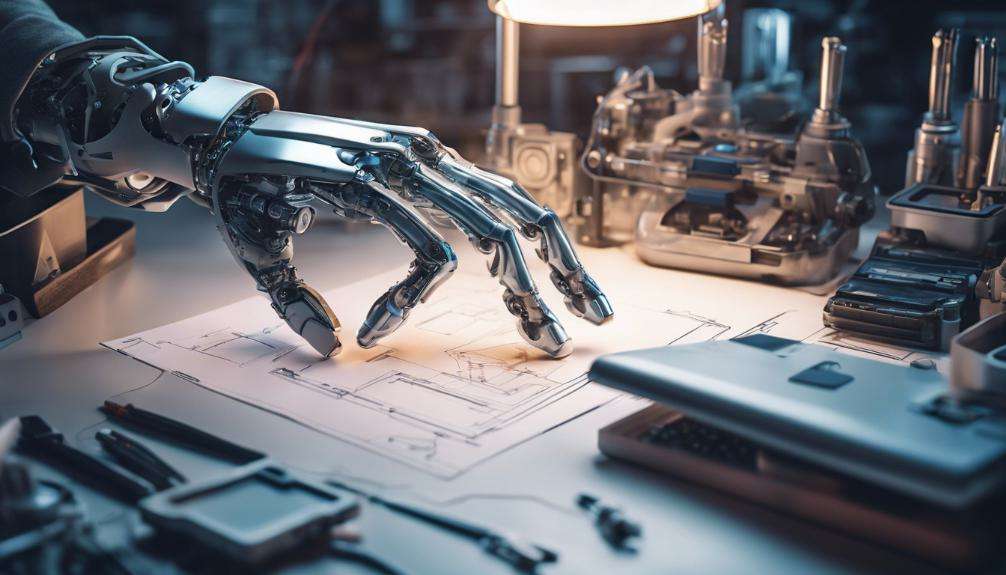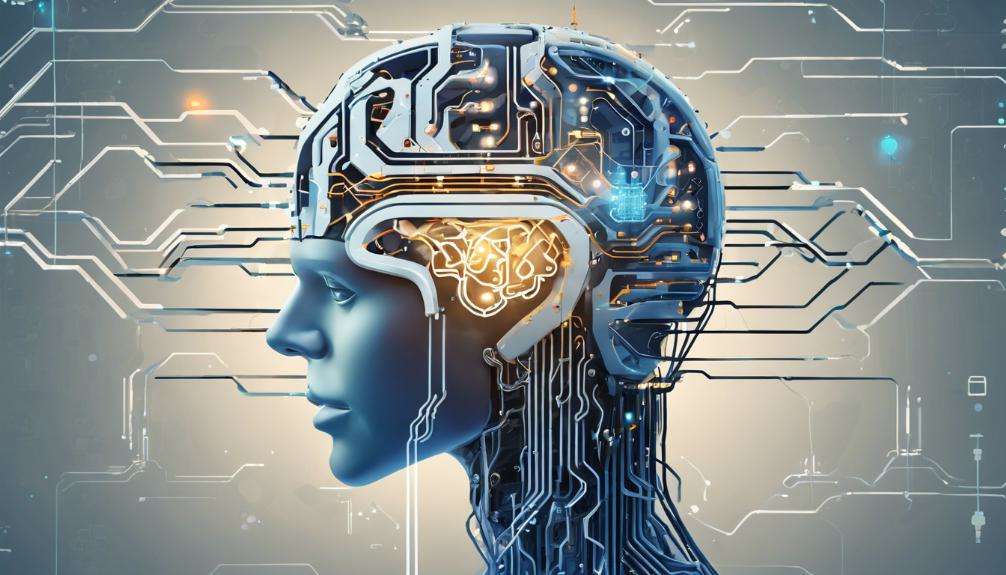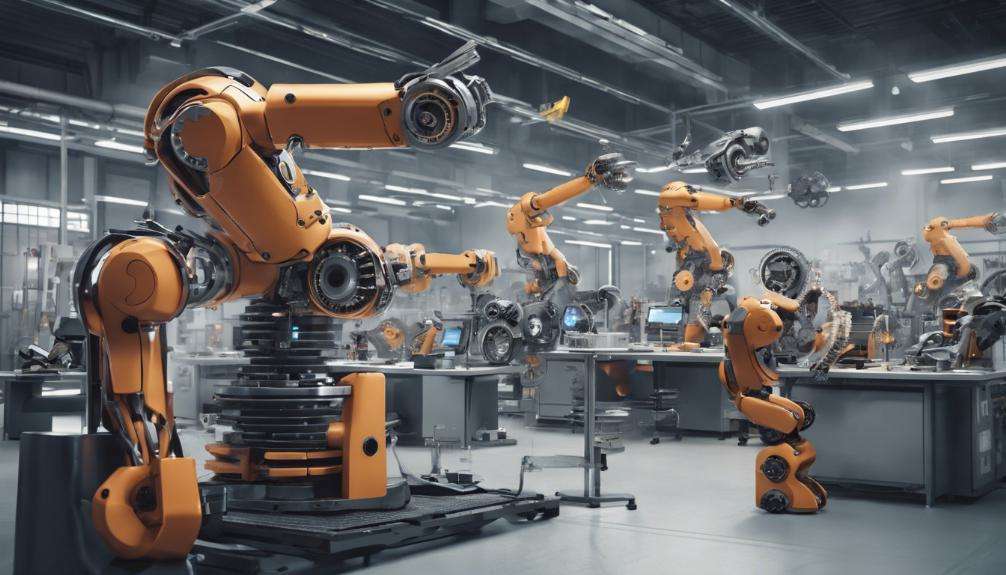Table of Contents
I've learned that Tool AI refers to the use of artificial intelligence as a supportive instrument, enhancing human abilities rather than replacing them. Developed from mid-20th century breakthroughs by pioneers like Alan Turing and John McCarthy, these AIs perform tasks with meticulous accuracy and speed, thanks to advanced algorithms and massive data processing capabilities. Across sectors like healthcare, finance, and manufacturing, Tool AI is revolutionizing processes by diagnosing diseases, predicting market trends, and optimizing production. Despite facing integration challenges and ethical concerns, the potential for growth and improvement is immense, hinting at an exciting future as we explore further.
Main Talking Points
- Tool AI refers to artificial intelligence used as an interactive instrument to extend human capabilities.
- It involves advanced algorithms, machine learning, and data processing for accurate and fast outcomes.
- Tool AI significantly impacts sectors like healthcare, finance, and manufacturing by optimizing processes and improving efficiency.
- Integration challenges include compatibility issues, resistance to adoption, and the need for training and data migration.
- Ethical considerations for Tool AI include ensuring privacy, security, and transparency, and managing bias in algorithms.
Defining Tool AI

Tool AI refers to a type of artificial intelligence designed specifically to function as an advanced, interactive instrument rather than an autonomous agent. It's crafted to assist users in achieving specific tasks by providing critical information, suggestions, or executing particular functions under human direction. Unlike general AI, which seeks to operate independently, Tool AI relies heavily on user inputs and commands to perform its duties.
I think of Tool AI as a highly specialized assistant, fine-tuned to excel in a narrow range of activities. It's not there to make its own decisions or learn autonomously beyond its programmed scope. Instead, it's an extension of the toolset available to a human, enhancing productivity and efficiency without crossing into the domain of self-directed action.
Historical Development
The exploration of Tool AI began as early experiments in computer science sought to create systems that could enhance human decision-making and productivity. I've observed that the origins trace back to the mid-20th century, predicated on the aspirations of pioneering figures like Alan Turing and John McCarthy, who envisioned machines that could simulate aspects of human intelligence. This initial phase didn't just aim to replicate human thought processes but also to supplement them with computational speed and accuracy.
As I investigate further, it's clear that the progression through the decades featured significant milestones driven by both theoretical research and practical applications. The 1970s and 1980s saw an expansion in the field's scope as researchers began to formalize algorithms that could handle specific tasks like problem-solving and logical reasoning without direct human oversight. By the 1990s, the focus had shifted slightly towards creating more user-friendly systems that could interact with users in a more natural, intuitive way.
Today, I recognize that these foundational efforts have culminated in sophisticated Tool AI systems that are integral to various industries, from finance to healthcare, where they assist in processing large datasets and making predictive analyses. This historical journey isn't just about technological evolution; it's a reflection of a broader vision of augmenting human capabilities.
Key Technologies

Exploring key technologies, we uncover how advanced algorithms, machine learning, and data processing systems form the backbone of today's Tool AI capabilities. I've found that these technologies aren't just essential; they're intricately designed to enhance and streamline how we handle data, interpret user inputs, and execute tasks efficiently.
At the heart lies machine learning. It's fascinating how it trains models to predict outcomes and make decisions based on vast datasets. I've seen it evolve from simple pattern recognition to handling dynamic learning without explicit programming. This adaptability is vital in environments where data influx never stops.
Then there's the role of advanced algorithms. These aren't your standard set of instructions. They're highly optimized to process data at incredible speeds and with remarkable accuracy. I'm particularly impressed by algorithms that continuously learn and improve themselves through exposure to new data without human intervention.
Lastly, robust data processing systems are indispensable. They manage and analyze large streams of data, making it possible for AI to operate in real-time. My interactions with these systems have shown me that their ability to swiftly process and retrieve information is what really powers the real-time responses of Tool AI.
Together, these technologies create a powerful framework that supports the sophisticated landscape of Tool AI, driving innovations that were once thought impossible.
Industry Applications
Delving into industry applications, I've observed how Tool AI revolutionizes sectors from healthcare to finance with its precision and efficiency. In healthcare, AI tools assist in diagnosing diseases with remarkable accuracy, analyzing vast datasets far quicker than any human could. They're not just crunching numbers; they're saving lives by identifying patterns that predict health outcomes.
In finance, these tools are reshaping how we manage and predict financial trends. They process market data in real-time, providing insights that help companies make more informed decisions about investments and risk management. It's not just about faster processing; it's about smarter, more reliable financial guidance.
In manufacturing, AI-driven robots and systems optimize production lines, enhancing productivity and reducing waste. These aren't your average assembly line machines; they adapt and learn, making real-time adjustments to improve efficiency and product quality.
The energy sector benefits similarly, with AI optimizing resource distribution and consumption, leading to significant cost savings and reduced environmental impact. These aren't just theoretical improvements; they're practical changes happening right now, fundamentally transforming how industries operate. Each application not only showcases Tool AI's versatility but also its indispensable role in modern industry.
Benefits of Specialization

Building on these industry applications, we see that specialization in Tool AI yields profound benefits across various sectors. By focusing on specific tasks, these AI tools excel, providing tailored solutions that enhance efficiency and effectiveness. Here's how specialization has a substantial impact on our work and daily life:
- Vital: Specialized AI tools are designed to perform specific tasks, often faster and with greater accuracy than humans. This specialization streamlines processes and saves time, allowing businesses to focus on innovation and growth.
- Explore: Implementing specialized AI can greatly reduce costs associated with human labor and error. Automation of repetitive tasks frees up resources, which can then be redirected towards more strategic activities.
- Best: With specialization, AI systems are finely tuned to produce excellent results in their respective areas. This leads to higher quality products and services, meeting consumer demands more effectively.
- Markedly: Specialized AI systems can be scaled up to handle increased loads without the need for proportional increases in human resources. This scalability is essential for businesses looking to expand without compromising on quality or performance.
As we dig deeper into the intricacies of Tool AI, it's clear that its specialized applications aren't just beneficial but essential for progress in various industries.
Integration Challenges
Despite the advantages of specialized Tool AI, integrating these systems into existing workflows presents significant challenges. One of the main hurdles I've encountered is compatibility. These AI tools often require specific infrastructural changes or software updates to function at their best. This isn't just time-consuming; it's costly, and not all businesses can afford these upfront investments.
There's also the issue of data. Tool AI systems thrive on high-quality, extensive data sets to perform accurately. However, gathering this data, ensuring its relevance, and maintaining privacy standards can be a monumental task. I've seen many situations where the lack of proper data governance leads to inefficiencies rather than improvements.
Training staff to use these AI tools effectively is another steep challenge. The learning curve can be significant, depending on the complexity of the AI solution. I've witnessed firsthand the resistance from employees who are either skeptical of AI or intimidated by the new technology. This resistance can slow down integration processes, impacting overall productivity.
Lastly, there's continuous maintenance. AI systems aren't set-and-forget solutions; they require ongoing updates and tuning to stay efficient. I've had to allocate resources continuously to make sure these tools perform well, adding another layer of complexity to their integration.
Future Trends

Looking ahead, the future of Tool AI promises significant evolution and broader adoption across various industries. As I explore this landscape, it's clear that we're on the brink of some transformative changes. Here's what excites me the most:
- Personalized Learning: AI tools will customize education to fit individual learning styles and speeds. Imagine a classroom where every student gets a personalized lesson plan that adapts in real-time.
- Healthcare Diagnostics: Tool AI will enhance the ability to analyze medical data, providing faster and more accurate diagnoses. This isn't just about efficiency; it's about saving lives with precision.
- Automation in Agriculture: From predicting crop yields to automating farming tasks, AI tools will revolutionize how we grow our food. This means higher productivity and sustainability in agriculture.
- Smart Cities: AI will play a pivotal role in managing everything from traffic to energy use in urban areas, making cities more livable and environmentally friendly.
These developments suggest a future where AI tools aren't just helpful; they're essential. They'll integrate seamlessly into our daily lives, making our usual tasks easier and introducing capabilities we haven't even imagined yet. I can't wait to see how these technologies unfold and reshape our world.
Ethical Considerations
As we embrace the advancements in Tool AI, we must also rigorously address the ethical implications these technologies bring. I'm particularly concerned about privacy and data security. With Tool AI's ability to process vast amounts of information, there's a real risk that sensitive personal data could be misused or mishandled. Ensuring robust encryption and strict access controls is paramount, but it's also imperative that I, as a user, stay informed about how my data is being used.
Another critical issue is the potential for bias in AI algorithms. If I'm not careful, these biases can perpetuate and even amplify existing social inequalities. It's my responsibility to demand transparency in how these algorithms are developed and to insist that diverse datasets are used for training. This is essential to prevent any discriminatory outcomes that could affect marginalized groups disproportionately.
Lastly, I'm aware of the accountability concerns surrounding Tool AI. When decisions are made by machines, figuring out who's responsible when things go wrong can be tricky. It's essential that I advocate for clear guidelines and legal frameworks to address these accountability issues, ensuring that there are mechanisms in place to handle any adverse effects swiftly and fairly.
Case Studies

To illustrate the impact of Tool AI, let's examine a few case studies that highlight both successes and challenges in its application.
- Healthcare Diagnostics: I've seen Tool AI revolutionize patient care by improving diagnostic accuracy. For example, AI algorithms can now detect diseases from medical images with precision comparable to or sometimes surpassing human experts. However, there's the challenge of integrating these systems into existing medical practices without disrupting workflows.
- Automotive Industry: Autonomous driving technology is a great success story for Tool AI. It's not just about cars driving themselves; it's about creating a safer driving environment. The challenge here lies in legislative and ethical considerations, which I find quite complex as they involve public safety and privacy concerns.
- Customer Service: AI-powered chatbots are now ubiquitous, providing 24/7 customer support. They've reduced response times and increased customer satisfaction. Yet, the challenge remains in making these interactions feel as natural and empathetic as human interactions.
- Finance Sector: Tool AI has been a game-changer in fraud detection by analyzing transaction patterns quickly and efficiently. However, the reliance on AI raises issues about transparency and the potential for biased decision-making.
Each case study reveals that while Tool AI's benefits are immense, they come with their own set of unique challenges that need careful consideration.
Frequently Asked Questions
How Does Tool AI Differ From General-Purpose Ai?
I'm not sure how to compare the two since I don't have information specifically on 'tool AI.'
In general, general-purpose AI is designed to perform a wide range of tasks, adapting to various scenarios without being confined to specific functions.
This contrasts with specialized AIs that are tailored for particular applications, potentially making general-purpose AI more flexible but perhaps less optimized for specific tasks than its specialized counterparts.
Can Tool AI Replace Human Jobs Entirely?
The question of whether AI can fully replace human jobs is complex.
I believe that while AI can automate many tasks, it's unlikely to replace human jobs entirely. Humans possess creativity, empathy, and adaptability that AI can't fully mimic. Plus, some roles require human oversight.
What Is the Initial Cost of Implementing Tool Ai?
The initial cost of implementing such advanced technology can vary widely depending on the scale and complexity of the system needed.
I'd estimate that for a small business, costs could start from a few thousand dollars, but for larger enterprises, it could run into millions.
You've got to take into account software, hardware, and possibly ongoing maintenance and training expenses.
It's definitely a significant investment, but the potential benefits could outweigh these initial costs.
How Does Tool AI Handle Unexpected Inputs or Anomalies?
When handling unexpected inputs or anomalies, it typically uses algorithms designed to detect and manage these irregularities.
It might flag them for human review or try to correct them automatically, depending on the severity and nature of the anomaly.
This approach helps maintain the system's stability and guarantees the outputs remain reliable, even when faced with data that deviates from the norm.
It's vital for maintaining overall performance and accuracy.
Are There Any Personal Privacy Risks With Tool Ai?
When considering any digital platform, I'm always cautious about personal privacy risks. It's essential to understand how data is collected, stored, and used.
Typically, privacy concerns include unauthorized access to sensitive information and the potential for data breaches.
I'd say it's important to review the privacy policies and make sure there are robust security measures in place to protect personal information from being compromised or shared without consent.
Conclusion
As I reflect on tool AI, it's clear that its specialized capabilities are transforming industries. The integration challenges, though significant, are manageable with thoughtful strategies.
Looking ahead, I'm excited about the future trends that promise even more sophisticated applications. However, we must remain vigilant about ethical considerations to guarantee these advancements benefit everyone.
The case studies we've explored underline the potential and power of tool AI when harnessed correctly. It's an exciting time to be involved in this field.

1 comment
[…] to build a profitable business in just a couple of hours a day. Embrace these techniques to unleash your business's full potential and reach your financial goals faster. Your success awaits with these proven […]